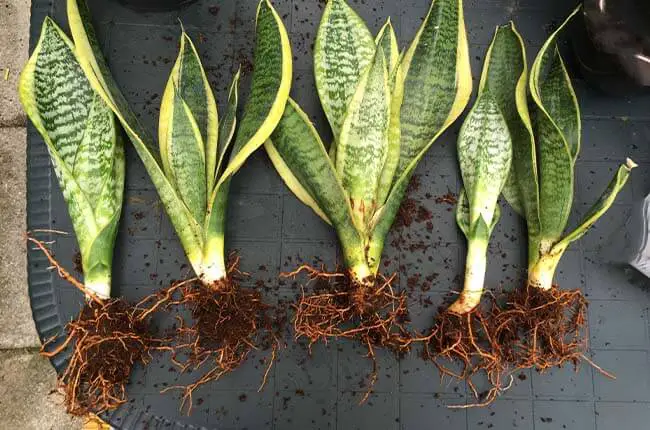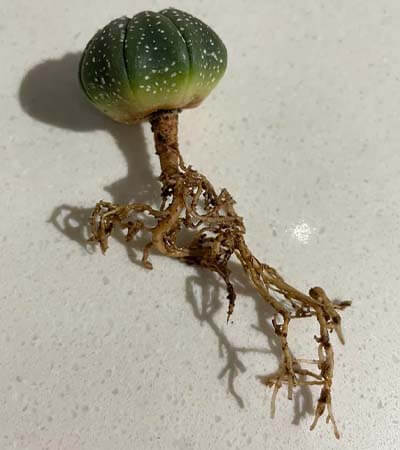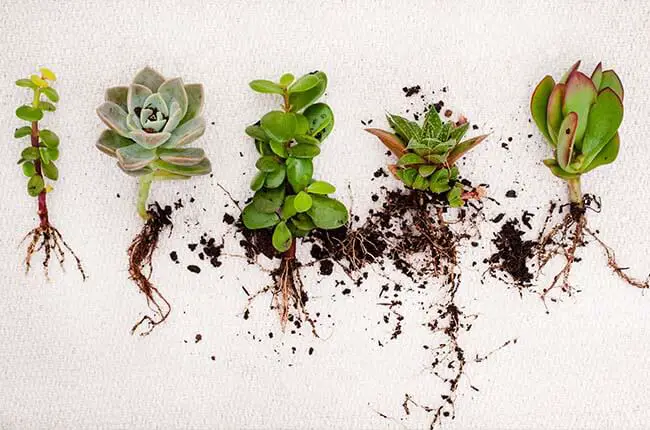Understanding the root system of succulents is crucial for their optimal growth and survival. Contrary to many plants, succulents exhibit a unique, predominantly shallow root system.
Stem succulents tend to have shallow but long fibrous roots that grow horizontally to quickly absorb water from intermittent rainfall in hot, dry climates. Those with tap roots are usually found in areas with compact soils for stability.
In this article, we’ll delve into the types of succulent roots, shedding light on how this characteristic impacts your choice of pot size and depth—a key decision in successfully growing these resilient species.
What types of succulent roots are there?
Their root systems can be classified as either deep-rooted or shallow-rooted, encompassing taproots and fibrous roots.
Fibrous roots
The majority of succulents have a shallow and wide fibrous root system characterized by numerous thin, branching roots spreading horizontally near the soil surface.
Their root system can be between 1 to 5 inches (13 cm) deep but can spread horizontally up to 4 feet (122 cm) long to collect water quickly.
This type of root system allows the plant to rapidly absorb water from light rainfall or surface watering, as commonly found in water-limited ecosystems and areas with intermittent moisture (e.g. the desert).
The long fibrous roots also help succulents stabilize themselves in rocky environments, as it is found that cacti grown alongside rocks have 7 times more lateral roots than those in rock-free areas (Nobel et al., 1992).
But the depth is largely influenced by the plant’s species, its native environment, and the soil composition. For example, desert-dwelling succulents often feature shallow roots to absorb as much water as possible during rare occasions of rainfall.
Tap roots
Some succulents possess a primary taproot that extends vertically downward, providing the plant with strong anchorage and access to water from deeper soil layers. This root system enables the succulents to withstand periods of drought better than their shallow-rooted counterparts.
Which succulents have shallow fibrous roots?
Most succulents and desert-dwelling cacti, even the towering Saguaro cactus, have shallow roots.
Succulents with shallow roots include species from the stonecrap family (Crassulaceae), such as Jade plant (Crassula ovata), Kalanchoe, Houseleek (Sempervivum), Aeonium, Sedum, Echeveria, and the lithops or mesembs family (Mesembryanthemaceae).
Echeveria
These attractive rosette-forming succulents have shallow, fibrous roots that spread horizontally close to the soil surface.
They are native to semi-desert regions of Central America and have adapted to the quick absorption of water during scarce rainfall. Water is stored in their thick, fleshy leaves.

Hawthorthia
Native to South Africa, Hawthorthia has a relatively shallow root system adapted to absorb water quickly from infrequent rainfall in its native habitats.
The roots are typically fibrous and can be quite thick, branching outward to efficiently capture water.
They might extend a few inches horizontally but do not penetrate deeply, typically no more than 1-2 inches (2.5 – 5 cm) down into the soil.
Sedum species
Sedum species, such as Burro’s Tail (Sedum morganianum), have a shallow and fibrous root system.
Native to southern Mexico’s dry regions, its shallow roots help it quickly absorb water during rare rains.
Its plump, trailing leaves store water.
Aloe vera
Aloe vera has long fibrous roots that can extend up to several feet.
Jade plant(Crassula ovata)
The Jade plant (Crassula ovata) has short, fibrous roots that typically extend about 2 inches (5 cm) deep which allows it to absorb any available water quickly.
It hails from the arid regions of South Africa, where rain is infrequent.
Jade plants store water primarily in their plump, glossy leaves and fleshy, hollow roots which are filled with spongy tissue.
Panda plant (Kalanchoe Tomentosa)
Known for its fuzzy, gray-green leaves that are covered in small hairs, Kalanchoe tomentosa has a shallow root system with many fine fibrous roots that can extend to 6 inches (15.24 cm) long.
Native to Madagascar, it has adapted to the dry climate by developing shallow roots for fast water absorption.
Its thick, fuzzy leaves are used for water storage.

Lithops
Also known as ice plants or living stones, Lithops have a shallow root system but can still extend to 6 inches (15 cm) deep.
Saguaro cactus
The tall Saguaro cactus also has shallow fibrous roots.
Even the roots of a mature 4-feet-tall Saguaro cactus would only be 3 to 5 inches (8-13 cm) deep, but radiating 4 feet (122 cm) from the main stem which allows it to collect up to 200 gallons (757 liters) of water during a rainfall.
Pincushion Cactus
Like many cactus species, the Pincushion (Mammillaria crinite) has shallow roots that typically extend 1.5 to 2 inches (3.8 to 5 cm) deep only.
It originates from high-altitude regions in Mexico, where the soil drains quickly. Its shallow roots enable it to catch water before it drains away.
It stores water in its cylindrical body.
Agave
Many Agave species have relatively short shallow roots. So they don’t require a lot of soil and can be grown in small containers. It has thick, fleshy leaves that store water, making it well-suited to dry climates.
Snake Plant (Sansevieria)
Snake plant has very shallow fibrous roots which are mostly located close to the surface. Its roots are naturally orange in color – so, nothing to worry about.

Zebra plant (Haworthia)
The Zebra plant (Haworthia) has a shallow, fibrous root system that forms a compact network that allows the plant to efficiently gather water and nutrients from the soil.
It naturally grows in the underbrush of South African forests, where it absorbs moisture from the relatively wet soil. This plant retains water in its distinctive striped leaves.
String of pearls (Senecio rowleyanus)
The String of pearls (Senecio rowleyanus) has shallow thin, delicate roots that allow this trailing plant to efficiently take up water and nutrients.
Originating from Southwest Africa, its shallow roots capture water from light, infrequent rainfall. The round “pearls” are leaves that store water.
Aeonium
Aeoniums have relatively shallow, fibrous root systems. These roots spread out horizontally close to the soil surface, helping the plants maximize water absorption during infrequent rainfalls. The shallow roots also allow them to be easily transferred and propagated.
Hens and chicks (Sempervivum)
Hens and chicks (Sempervivum) have shallow, fibrous roots that grow close to the soil surface, making them drought-tolerant and easy to propagate.
It is native to the mountainous regions of Southern Europe, where the soil is rocky and drains quickly.
It is adapted to this environment with shallow roots for quick water absorption and rosette leaves that store water.
Which succulents have deep roots?
Certain succulents develop deeper tap roots which is a larger, central root from which other roots sprout laterally.
The growing medium also plays a significant role in the formation of tap roots. In loose, sandy soils, you’ll find a broader and more dispersed fibrous root system as roots can easily navigate through the soil. On the other hand, compact soils may push the succulent to grow deeper roots for stability.
A thick tap root enables the plant to efficiently absorb and store water, ensuring its survival in environments where rainfall is scarce and unpredictable.
Apart from offering stability and storing water, their deeper roots also allow them to access water and nutrients from deeper into the soil where surface resources are limited.
Here are some examples:
Star cactus (Astrophytum)
Characterized by a star-like appearance, some Astrophytum cactus species can develop a taproot system under certain conditions. Species like Astrophytum myriostigma, for example, are known to occasionally develop taproots.
A key feature of Astrophytum roots is their capacity for regrowth. If an Astrophytum is uprooted or if the roots are damaged, the plant has the ability to grow new roots from the base of the stem. This adaptation further contributes to their survivability in harsh environments.

Desert Rose (Adenium obesum)
The Desert Rose is a succulent plant native to Africa and Arabia and is known for its swollen, bulbous stem and striking pink or red flowers.
Its large, pronounced taproot is designed to store water during periods of drought and can reach depths of 12-24 inches (30.5-61 cm) depending on the age and size of the plant.
Elephant’s foot (Dioscorea elephantipes)
The Elephant’s foot plant is an unusual succulent known for its thick, bark-like stem that resembles an elephant’s foot. It has a deep taproot that can extend up to 20-24 inches (50.8-61 cm) into the ground.
Ocotillo (Fouquieria splendens)
Native to the deserts of Southwest U.S. and Mexico, Ocotillo is known for its tall, slender, and spiny stems. It has a deep taproot system that can reach depths of 36 inches (91 cm), allowing it to access deep groundwater in its native desert environment.
How to choose pot size for succulents?
For shallow-rooted succulents, shallow and wide pots work best. They promote quick soil drying and prevent waterlogging, replicating the arid environments these plants are accustomed to.
Examples of suitable pots for shallow-rooted succulents include bonsai pots or even dishes with drainage holes. Choose a shallow pot that accommodates its root structure and ensures it has good drainage.
In contrast, deep-rooted succulents require pots that can accommodate their extensive root systems. These should be deep enough to allow the roots to spread appropriately and offer the required stability for the plant.
Ceramic or terra cotta pots are often good choices, as they also provide excellent drainage and prevent water from stagnating around the roots.
Deep-rooted succulents may also require a bit more time between waterings due to their ability to tap into deeper moisture reserves.
You should water them thoroughly and then allow the soil to dry out completely before the next watering.
As a general rule, allow the soil to dry out completely before rewatering. However, shallow-rooted succulents will likely need watering more frequently than deeper-rooted ones due to their limited access to deeper soil moisture.
Misconceptions about succulent roots and pots
One common misunderstanding is that all succulents have the same type of root system and thus require the same pot size. As we have seen, succulents can have either shallow or deep roots, each with specific pot size and care requirements.
Another misconception is that succulents with deeper roots need more frequent watering. However, these plants are often better adapted to accessing deeper moisture reserves and may require less frequent watering.
Understanding these nuances is crucial for successful succulent care. It allows us to meet the needs of each plant better, promoting healthier growth and more vibrant displays. As succulent enthusiasts, it’s always a joy to delve deeper into the fascinating world of these resilient plants, learning more about their unique adaptations and how we can support their growth.
Happy gardening!
Related
Why My Succulent Has Aerial Roots (Is It Bad?)
Reference
Nobel, P.S., Miller, P.M. & Graham, E.A (1992). Influence of rocks on soil temperature, soil water potential, and rooting patterns for desert succulents. Oecologia 92, 90–96. https://doi.org/10.1007/BF00317267
- Keiki Paste vs Rooting Hormone:What’s the difference? - February 4, 2024
- Top 10 Orchid Fertilizers: A Comprehensive Review (2024) - February 2, 2024
- Top 8 Soil Inoculants For Stronger Plants (2024) - February 1, 2024

